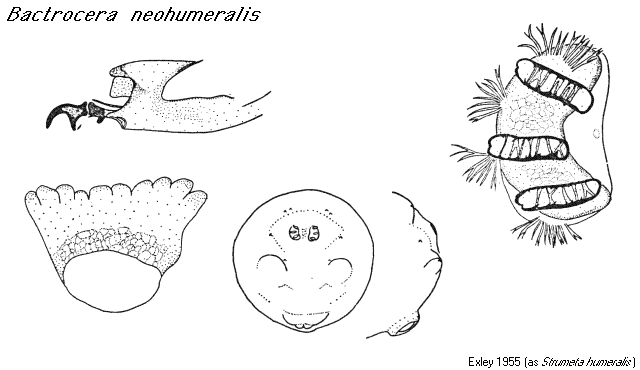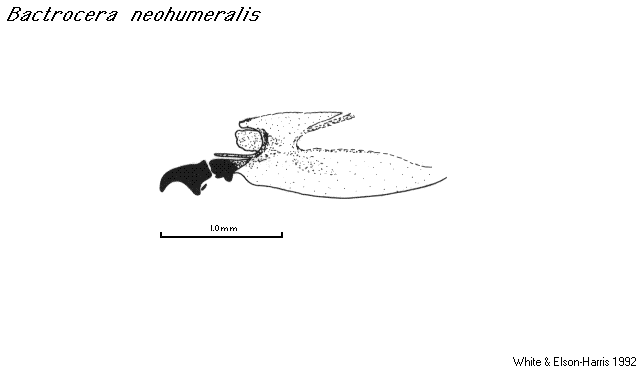Bactrocera neohumeralis
Description
Typical of Bactrocera larvae with the following specific characteristics for the third instar:
Body. Body length 7–9.5mm.
Head. Stomal organ: number of peg sensilla two or three (often 2 long, tapered and branched); other peg-sensilla-like structures absent. Stomal region: secondary lobes short, leaf-like (5–6 preoral lobes); margins of secondary lobes all entire. Number of oral ridges 8–12; margins scalloped (short, tapering, bluntly rounded teeth; some fringelike). Accessory plates large; number of accessory plates 6–8; margins serrated. Median oral lobe absent or not protruding.
Spinules and creeping welts. Dorsal spinules on segments T1-T3.
Anterior spiracles. Anterior spiracle convex to flat. Anterior spiracular tubules 9–12.
Caudal segment (a8) and anal lobes. Anal lobes plainly visible, but not protuberant; simple (?).
Posterior spiracles. Slits 2.5–3x longer than wide (about). Dorsal spiracular processes with numerous trunks arising from an elongate base (medium processes). Number of dorsal spiracular processes 16–20. Number of ventral spiracular processes 16–20. Number of lateral spiracular processes 6–12.
Host plants
| Family | Genus |
| Anacardiaceae | Mangifera, Spondias |
| Annonaceae | Annona, Cananga |
| Arecaceae | Phoenix |
| Capparaceae | Crateva |
| Combretaceae | Terminalia |
| Moraceae | Ficus, Morus |
| Myrtaceae | Eugenia, Feijoa, Psidium, Syzygium |
| Passifloraceae | Passiflora |
| Rosaceae | Eriobotrya, Fragaria, Malus, Prunus, Pyrus, Rubus |
| Rubiaceae | Coffea |
| Rutaceae | Casimiroa, Citrus, Fortunella |
| Solanaceae | Solanum |
| Vitaceae | Vitis |
Part of plant attacked: fruit.
Biogeographic region and distribution
AustralasianPapua New Guinea, Australia (Qld., NSW).
Adult taxonomy
Bactrocera (Bactrocera) neohumeralis HardyDacus tryoni var. neohumeralis Hardy 1951: 169.—n. n. humeralis Perkins 1934.
Chaetodacus humeralis Perkins 1934: 42.—Australia. Queensland: Cairns. LT ♀ QMBA. Preocc. Bezzi 1915; Lectotype designated by Drew 1989: 115.
Chaetodacus tryoni var. sarcocephali: Tryon 1927: 188.—misid. In part, see Drew 1989: 114.
References
Carroll, L. E., A. L. Norrbom, M. J. Dallwitz, and F. C. Thompson. 2004 onwards. Pest fruit flies of the world – larvae. Version: 8th December 2006. http://delta-intkey.com.
White, I. M., and M. M. Elson-Harris. 1992. Fruit flies of economic significance: their identification and bionomics. CAB International; Wallingford, UK. 601 p.




